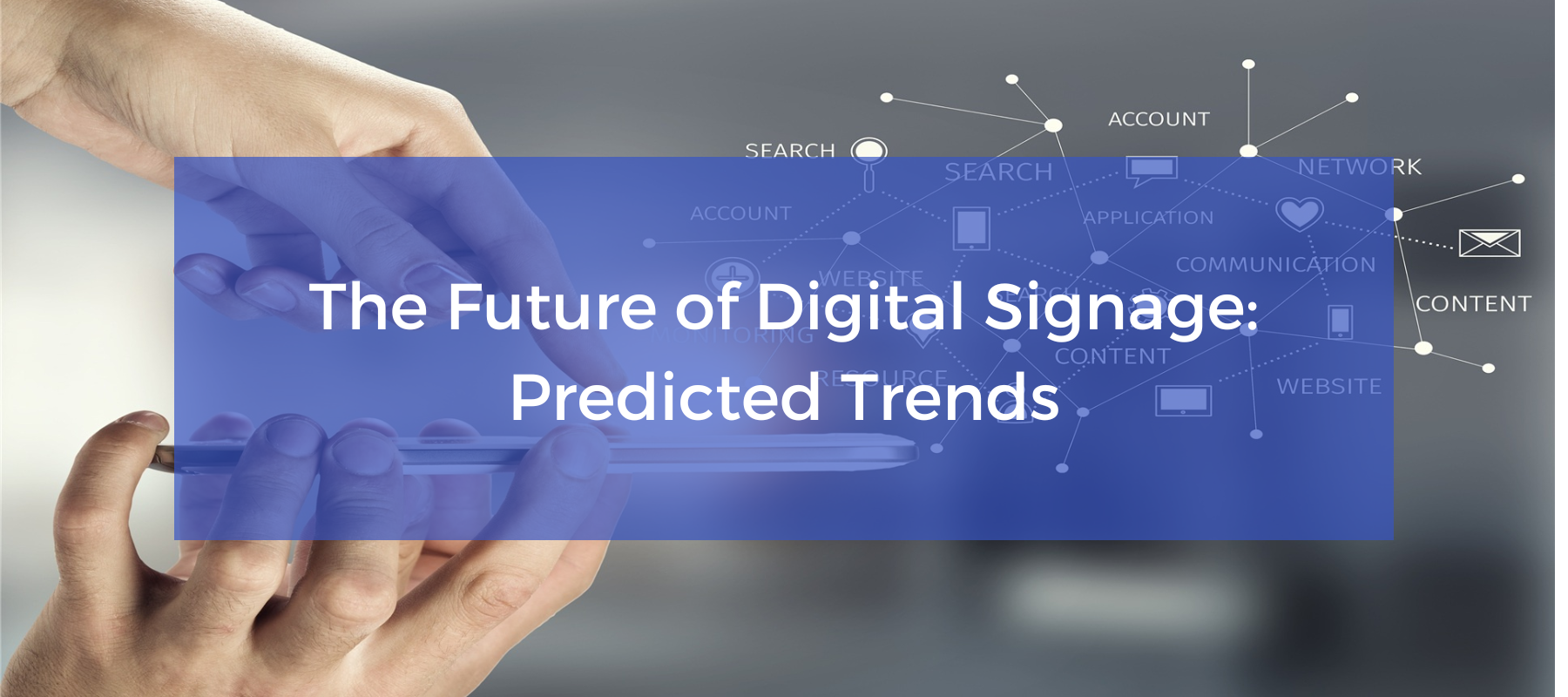
The Future of Digital Signage: Predicted Trends
Digital signage is an increasingly popular way for businesses to manage their customer experience and reach new audiences. The technology has evolved over the years, allowing companies to create more sophisticated and interactive displays that can be used for a variety of purposes.
With advances in digital display technologies, future trends in the industry are sure to be exciting. In this article, we'll explore the latest trends in digital signage and how they are likely to shape the future of this technology. We'll look at innovations in display technologies, interactive features, and more as we take a peek into what's next for digital signage. So let's get started!
Why is Digital Signage Gaining Popularity?
Digital signage is becoming increasingly popular for a number of reasons. First, it offers an easy way to get messages across to customers and staff quickly and efficiently. Companies can create eye-catching visuals, videos, and other content that captures the attention of viewers instantly. This helps to draw people in, while also providing them with the information they need.
Additionally, digital signage is cost-effective and easy to manage. Compared to traditional forms of advertising such as print or radio, digital signs can be updated easily and quickly at any time with the latest content. This allows businesses to keep up with changing trends and customer needs without having to invest in costly redesigns or campaigns.
Finally, digital signage provides businesses with the ability to track and measure their performance. These signs can be used to collect data on customer behavior, which allows companies to gain valuable insights into customer preferences and buying habits. This data can then be used to inform future marketing campaigns and strategies, making digital signage an invaluable tool when it comes to staying ahead of the competition.
Digital signage offers businesses a powerful and cost-effective way to reach out to their customers, staff, partners, and other stakeholders. With its easy-to-manage setup and data tracking capabilities, it's no wonder why more companies in various industries are turning to digital signage as part of their marketing strategy.
What is the Future of Digital Signage?
Digital signage technologies are evolving. From integrating artificial intelligence to seeing live streams in digital displays, here’s what we can expect.
Automation & AI
The use of automation and artificial intelligence in digital signage is a revolutionary trend in the industry. Automation can be used to streamline processes, free up personnel to focus on more important tasks, and reduce errors in data collection and management. AI-powered analytics can help businesses gain deeper insights into customer behavior, allowing them to tailor content specifically for their target audience.
With the use of automation and AI, digital signage is becoming more efficient and powerful, offering businesses an incredible opportunity to connect with their customers in creative ways. Furthermore, these technologies allow for real-time updates and upgrades without manual intervention, meaning businesses can stay ahead of the curve in terms of their digital signage content.
Interactivity
Interactivity in digital signage is the next big thing. By allowing customers to interact with their displays, businesses are creating a more personalized experience that can increase engagement and drive sales.
Digital signage technology is becoming increasingly sophisticated and intuitive, enabling users to access multimedia content such as videos, images, audio clips, and 3D graphics. This allows for an interactive experience that can be tailored to a specific audience, allowing for greater control and more effective marketing.
Facial Recognition Screens
Facial recognition screens are becoming an increasingly popular technology for businesses to integrate into digital signage. With facial recognition, businesses can accurately identify individuals and groups, as well as track customer behaviors in real-time.
In addition, this technology allows companies to provide a more personalized experience by recognizing customers who have previously visited their establishment. This helps create a sense of customer loyalty and increases customer satisfaction.
Furthermore, facial recognition screens are beneficial for security purposes as they can be used to detect intruders or suspicious activity. By integrating facial recognition technology into digital signage, businesses can improve their overall security as well as increase their operational efficiency.
Livestreaming
Livestreaming can be a powerful tool for digital signage, allowing businesses to quickly and effectively reach large audiences, with minimal costs and setup. With livestreaming, businesses can deliver timely information in real time to their users, such as news updates, event coverage, or promotional specials. Livestreams also provide an interactive platform for customers to engage with the business, thereby increasing customer loyalty and driving sales.
Businesses can use live-streaming technology to create more immersive experiences for customers, such as virtual tours of their stores or new product rollouts.
Cloud-Based Deployment
Cloud-based deployment is an increasingly popular choice for digital signage applications. This type of deployment eliminates the need to install and maintain bulky, expensive hardware on-site or at a centralized location. Instead, cloud-based solutions enable users to access their content and manage their signage network from anywhere with an internet connection.
With a cloud-based deployment, users can easily scale their display network up or down as needed. This means that a cloud-based platform allows digital signage content to be quickly and easily distributed to multiple displays in different locations with minimal effort.
Additionally, cloud-based deployments offer the ability to centrally manage your digital signage network from one central dashboard, allowing for greater control over scheduling, content, and display settings. They further increase the convenience of keeping content up-to-date by automatically pushing the latest updates to all displays in a network.
Innovations in Touch Screen Technology
The introduction of touchscreen technology in digital signage is a major game changer for the industry. Thanks to this innovative development, it’s now possible to create interactive and engaging experiences that draw attention and capture consumer interest.
Touchscreens can be used to trigger images, videos, or any other content at the point of sale. They can also be used to connect customers with the brand in a way that goes beyond visuals.
Touchscreen technology has continued to evolve over the years, and new advancements are making it even more powerful and versatile. For example, multi-touch screening capabilities enable users to interact with multiple elements on the screen simultaneously, providing an immersive experience.
Haptic feedback technology enables devices to simulate real-world touch sensations, creating a more realistic and engaging experience. Improved screen resolutions and faster processing speeds make it possible to display high-quality content in an instant, making digital signage solutions much more attractive.
Touchscreen technology has, and will continue to revolutionize the way people interact with digital signage displays.
Sensors
Sensors are an essential component of digital signage. They provide the necessary data to enable automated, real-time decision-making and content adjustments. The most common types of sensors used in digital signage include motion sensors, ambient light sensors, audio sensors, temperature sensors, and humidity sensors.
- Motion sensors - allow a system to detect the movement of people in the vicinity. This is useful as it can be used to trigger content changes or alert systems if certain movements are detected.
- Ambient light sensors - allow a system to adjust the brightness and color temperature of the display based on the amount of sunlight present in the environment, ensuring optimal visibility during different parts of the day.
- Audio sensors - allow a system to detect sound levels and adjust audio output accordingly.
- Temperature sensors - enable a system to measure the room temperature and adjust the display brightness or color temperature as necessary.
- Humidity sensors - allow a system to monitor air quality in order to protect digital components from dampness.
These sensors enable digital signage systems to provide dynamic and personalized content that is tailored to the environment and user behavior. By utilizing data generated from sensors, digital signage can optimize usage patterns and deliver a better experience for users.
Prepare Your Organization for the Future
When preparing your organization for the future of digital signage, it is essential to begin by considering the trends in digital signage and how they may impact your business.
Several key trends have emerged, including a shift towards free interactive displays, digital sign reseller program, facial recognition, cloud-based deployment, and integration with other technologies such as artificial intelligence, the Internet of Things, and voice-based user interfaces.
To properly prepare for these changes, businesses need to understand how digital signage can help them increase customer engagement, improve operational efficiency, provide more targeted marketing campaigns, and gain a better understanding of their customer’s behaviors. Manufacturers, in particular, are embracing advanced manufacturing digital signage solutions that deliver real-time insights and transform production floor communication, driving overall operational excellence.
More From Our Blog
-

Screen Sharing for Workplace Collaboration | Rise Vision
Screen-sharing technology has transformed how teams communicate and work together in real-time, regardless of their location. It can make presentations more engaging, support remote work, and speed[…]
Read More -

How to Use PowerPoint for Digital Signage
To create stunning, attention-grabbing, and effective digital signage content, you need the help of content creation and presentation tools. One of the most popular is Microsoft PowerPoint, owing to[…]
Read More -

120 Digital Signage Content Ideas
So…. you decided you would invest in some digital signage software and you need some ideas for ways you can make it stand out. This article is your go-to source for the best digital signage content[…]
Read More
Keep Your Displays Interesting – Pick New Templates Every Week!
Every week, we send template recommendations that will make you look great and improve your audience experience. And the best part, they save up to 16 hours of content creation time every week!
12,300+ Organizations Trust Rise Vision, You Can Too
Schedule a Free Demo
You deserve the #1 all-in-one platform for digital signage, screen sharing, and emergency alerts.



































